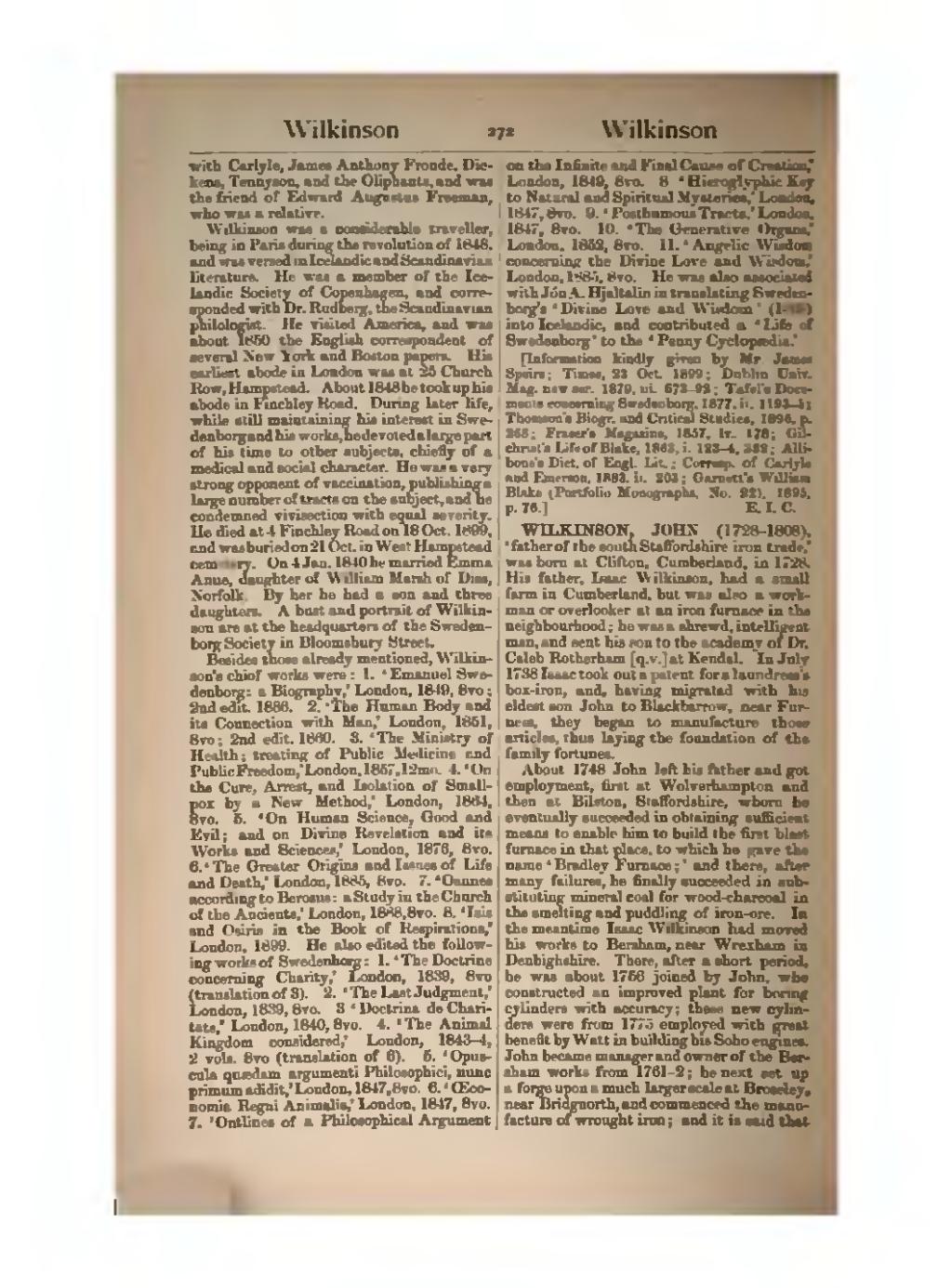with Carlyle, James Anthony Froude, Dickens, Tennyson, and the Oliphants, and was the friend of Edward Augustus Freeman, who was a relative.
Wilkinson was a considerable traveller, being in Paris during the revolution of 1848, and was versed in Icelandic and Scandinavian literature. He was a member of the Icelandic Society of Copenhagen, and corresponded with Dr. Rudberg, the Scandinavian philologist. He visited America, and was about 1850 the English correspondent of several New York and Boston papers. His earliest abode in London was at 25 Church Row, Hampstead. About 1848 he took up his abode in Finchley Road. During later life, while still maintaining his interest in Swedenborg and his works, he devoted a large part of his time to other subjects, chiefly of a medical and social character. He was a very strong opponent of vaccination, publishing a large number of tracts on the subject, and he condemned vivisection with equal severity. He died at 4 Finchley Road on 18 Oct. 1899, and was buried on 21 Oct. in West Hampstead cemetery. On 4 Jan. 1840 he married Emma Anne, daughter of William Marsh of Diss, Norfolk. By her he had a son and three daughters. A bust by F. Leifchild and a portrait of Wilkinson are at the headquarters of the Swedenborg Society in Bloomsbury Street.
Besides those already mentioned, Wilkinson's chief works were: 1. ‘Emanuel Swedenborg: a Biography,’ London, 1849, 8vo; 2nd edit. 1886. 2. ‘The Human Body and its Connection with Man,’ London, 1851, 8vo; 2nd edit. 1860. 3. ‘The Ministry of Health; treating of Public Medicine and Public Freedom,’ London, 1857, 12mo. 4. ‘On the Cure, Arrest, and Isolation of Smallpox by a New Method,’ London, 1864, 8vo. 5. ‘On Human Science, Good and Evil; and on Divine Revelation and its Works and Sciences,’ London, 1876, 8vo. 6. ‘The Greater Origins and Issues of Life and Death,’ London, 1885, 8vo. 7. ‘Oannes according to Berosus: a Study in the Church of the Ancients,’ London, 1888, 8vo. 8. ‘Isis and Osiris in the Book of Respirations,’ London, 1899. He also edited the following works of Swedenborg: 1. ‘The Doctrine concerning Charity,’ London, 1839, 8vo (translation of 3). 2. ‘The Last Judgment,’ London, 1839, 8vo. 3. ‘Doctrina de Charitate,’ London, 1840, 8vo. 4. ‘The Animal Kingdom considered,’ London, 1843–4, 2 vols. 8vo (translation of 6). 5. ‘Opuscula quædam argumenti Philosophici, nunc primum edidit,’ London, 1847, 8vo. 6. ‘Œconomia Regni Animalis,’ London, 1847, 8vo. 7. ‘Outlines of a Philosophical Argument on the Infinite and Final Cause of Creation,’ London, 1849, 8vo. 8. ‘Hieroglyphic Key to Natural and Spiritual Mysteries,’ London, 1847, 8vo. 9. ‘Posthumous Tracts,’ London, 1847, 8vo. 10. ‘The Generative Organs,’ London, 1852, 8vo. 11. ‘Angelic Wisdom concerning the Divine Love and Wisdom,’ London, 1885, 8vo. He was also associated with Jón A. Hjaltalín in translating Swedenborg's ‘Divine Love and Wisdom’ (1869) into Icelandic, and contributed a ‘Life of Swedenborg’ to the ‘Penny Cyclopædia.’
[Information kindly given by Mr. James Speirs; Morning Light, 18 Nov. 1899; Times, 23 Oct. 1899; Dublin Univ. Mag. new ser. 1879, iii. 673–92; Tafel's Documents concerning Swedenborg, 1877, ii. 1193–5; Thomson's Biogr. and Critical Studies, 1896, p. 268; Fraser's Magazine, 1857, lv. 178; Gilchrist's Life of Blake, 1863, i. 123–4, 382; Allibone's Dict. of Engl. Lit.; Corresp. of Carlyle and Emerson, 1883, ii. 203; Garnett's William Blake (Portfolio Monographs, No. 22), 1895, p. 76.]
WILKINSON, JOHN (1728–1808), ‘father of the south Staffordshire iron trade,’ was born at Clifton, Cumberland, in 1728. His father, Isaac Wilkinson, had a small farm in Cumberland, but was also a workman or overlooker at an iron furnace in the neighbourhood; he was a shrewd, intelligent man, and sent his son to the academy of Dr. Caleb Rotherham [q. v.] at Kendal. In July 1738 Isaac took out a patent for a laundress's box-iron, and, having migrated with his eldest son John to Blackbarrow, near Furness, they began to manufacture those articles, thus laying the foundation of the family fortunes.
About 1748 John left his father and got employment, first at Wolverhampton and then at Bilston, Staffordshire, where he eventually succeeded in obtaining sufficient means to enable him to build the first blast furnace in that place, to which he gave the name ‘Bradley Furnace;’ and there, after many failures, he finally succeeded in substituting mineral coal for wood-charcoal in the smelting and puddling of iron-ore. In the meantime Isaac Wilkinson had moved his works to Bersham, near Wrexham in Denbighshire. There, after a short period, he was about 1756 joined by John, who constructed an improved plant for boring cylinders with accuracy; these new cylinders were from 1775 employed with great benefit by Watt in building his Soho engines. John became manager and owner of the Bersham works from 1761–2; he next set up a forge upon a much larger scale at Broseley, near Bridgnorth, and commenced the manufacture of wrought iron; and it is said that
